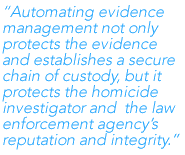 COLORADO SPRINGS, CO (Jan 7, 2014) – Once a homicide investigator collects evidence at a crime scene, he is responsible for making sure that this evidence is brought to a property room and placed in a locker for processing. Because that evidence is instantly linked to a case, there is urgency in securing and preserving it. According to John San Agustin, inspector with the El Paso County, Colorado, Sheriff’s Office, “The key thing here is that the chain of custody has to be place.”
What’s more, San Agustin continues, “The integrity of the evidence is important because you don’t know if there’s any trace evidence (DNA, any type of impressions) on that evidence item. You’ve got to maintain the sterility of the evidence.”
COLORADO SPRINGS, CO (Jan 7, 2014) – Once a homicide investigator collects evidence at a crime scene, he is responsible for making sure that this evidence is brought to a property room and placed in a locker for processing. Because that evidence is instantly linked to a case, there is urgency in securing and preserving it. According to John San Agustin, inspector with the El Paso County, Colorado, Sheriff’s Office, “The key thing here is that the chain of custody has to be place.”
What’s more, San Agustin continues, “The integrity of the evidence is important because you don’t know if there’s any trace evidence (DNA, any type of impressions) on that evidence item. You’ve got to maintain the sterility of the evidence.”
It is important as well to know who collected the evidence and where they collected it from so that if they are ever questioned about specifics regarding the evidence, they can testify in an informed manner. And how the evidence was collected is important---were gloves and plastic bags (which can degrade the value of the evidence) used?.
Automating Evidence Management Protects Investigators and Evidence - These circumstances make it clear why a reliable evidence management system must be in place. Older methods were manual, which means evidence intake and chain of custody was documented on paper. “By automating, you can enter data one time and then incorporate it into other fields over and over again electronically without ever having to write it again,” San Agustin said. Since it took from the time the evidence was collected until it was deposited into an evidence facility.” An automated system speeds up these steps.homicide investigators deal with evidence routinely, an automated evidence management software package like EvidenceOnQ is ideal. It’s easy to see why. If a homicide investigator has a good case and there’s DNA, and the defense attorneys know that it is the suspect’s DNA, or that there are footprint impressions or fingerprints, “They can start to hammer on issues of how the evidence was handled,” San Agustin explained. “It can be an issue of time and how long it took from the time the evidence was collected until it was deposited into an evidence facility.” An automated system speeds up these steps.
paper. “By automating, you can enter data one time and then incorporate it into other fields over and over again electronically without ever having to write it again,” San Agustin said. Since it took from the time the evidence was collected until it was deposited into an evidence facility.” An automated system speeds up these steps.homicide investigators deal with evidence routinely, an automated evidence management software package like EvidenceOnQ is ideal. It’s easy to see why. If a homicide investigator has a good case and there’s DNA, and the defense attorneys know that it is the suspect’s DNA, or that there are footprint impressions or fingerprints, “They can start to hammer on issues of how the evidence was handled,” San Agustin explained. “It can be an issue of time and how long it took from the time the evidence was collected until it was deposited into an evidence facility.” An automated system speeds up these steps.
Evidence Accountability Is Crucial - All of us realize evidence is needed to put bad guys behind bars. But San Agustin worries that, from a law enforcement perspective, evidence is not treated with nearly the importance that is required. “Which is why tools like EvidenceOnQ become extremely important because it tracks evidence from the date it was entered and at any time it has been checked out,” San Agustin said. Furthermore, a homicide detective is responsible for assuring that all pieces of evidence associated with a case can be accounted for right from the day of the murder and into the days that follow. Luckily, a complete software program like EvidenceOnQ can document all evidence entered into it, including any photos and video of evidence. San Agustin says this helps protect the integrity of the crime scene and the evidence itself.
 One-Time Only Data Entries - A huge benefit of automating evidence management is that it stops the repetitiveness of having to document evidence on paper. With a homicide investigation, it’s common to collect hundreds of pieces of evidence. So, using special software, once you enter the crime scene address or suspect information, you never have to enter it again. Likewise, when you start dealing with makes and models of guns and serial number, for example, you can make a mistake in your handwriting (with a manual system) and this can be misinterpreted by an evidence custodian or some other person. “The software really creates some checks and balances for scene and suspect information,” San Agustin said.
One-Time Only Data Entries - A huge benefit of automating evidence management is that it stops the repetitiveness of having to document evidence on paper. With a homicide investigation, it’s common to collect hundreds of pieces of evidence. So, using special software, once you enter the crime scene address or suspect information, you never have to enter it again. Likewise, when you start dealing with makes and models of guns and serial number, for example, you can make a mistake in your handwriting (with a manual system) and this can be misinterpreted by an evidence custodian or some other person. “The software really creates some checks and balances for scene and suspect information,” San Agustin said.
 Software Shows All Related Evidence Items, Allows Cross-reference With Other Cases - A major benefit with the EvidenceOnQ software that San Agustin uses is
Software Shows All Related Evidence Items, Allows Cross-reference With Other Cases - A major benefit with the EvidenceOnQ software that San Agustin uses is
that within minutes of making all entries he and other homicide investigators can see everything they have in acase. “So, when I’m looking at a particular homicide and I notice we’ve collected some clothing, potential items that may have DNA, I can determine right away if I need to, say, send these off to a state lab or to a particular forensics expert for analysis,” San Agustin said. “With a paper driven evidence management system, you don’t have the ability to do any kind of search function.”
Still another feature that EvidenceOnQ offers is that it allows the investigator to see some cross references to other cases. The benefit, says San Agustin, is that the software “allows you to see how a crime linked by several cases might be bigger than the single case you’re investigating. You can also see if there are any additional crimes that the same suspect has committed.”
Automating evidence management not only protects the evidence and establishes a secure chain of custody, but it protects the homicide investigator and everyone who deals with evidence. It also protects the law enforcement agency’s reputation and integrity. Without this kind of protection, the property room in any agency is a ticking time bomb that can explode at any time. Poses San Agustin: “Do you want to be the agency that’s going to wait until that happens, or are you going to take a more aggressive and proactive approach to how evidence is accounted for so you can confidently say that every piece of evidence collected at a crime scene is in your facility and right where it’s supposed to be?”

